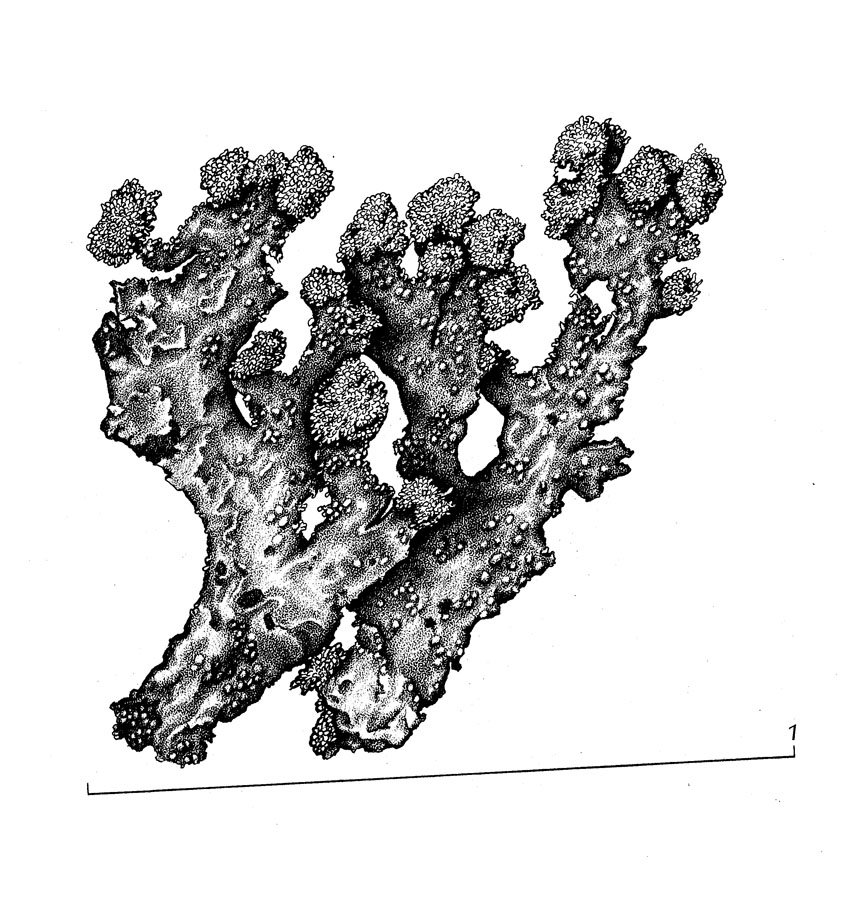
Consortium of Lichen Herbaria
- building a Global Consortium of Bryophytes and Lichens as keystones of cryptobiotic communities -
- Home
- Search
- Images
- Species Checklists
- US States: O-Z >
- US National Parks
- Central America
- South America
- US National Parks
- Southern Subpolar Region
|
Family: Parmeliaceae |
Nash, T.H., Ryan, B.D., Gries, C., Bungartz, F., (eds.) 2002. Lichen Flora of the Greater Sonoran Desert Region. Vol 1. Life habit: lichenized Thallus: foliose, rosette-forming (with ± centrifugal growth), to 6 (-10) cm diam., adnate, closely adpressed lobes: linear (strap-shaped) to sublinear, ± radiating, discrete and divaricate, or contiguous to overlapping; 0.2-1 (-1.5) mm wide, thin; tips: incised, eciliate upper surface: pale greenish- to grayish- yellow or whitish gray to bluish or slightly greenish, generally dull in center and shiny at lobe margins, without pseudocyphellae or distinct maculae soralia: present, round, laminal or terminal, 10-20 µm thick upper cortex: palisade plectenchmatous, covered by pored epicortex medulla: white, of densely interwoven hyphae; cell walls: containing isolichenan photobiont: primary one a Trebouxia, secondary photobiont absent lower cortex: paraplectenchymatous, 5-20 µm thick lower surface: whitish to pale or dark brown to black, rhizinate; rhizines: moderately dense, usually concolorous with lower surface (to darker), simple or sparsely furcated Ascomata: rare, apothecial, laminal, sessile or somewhat elevated (shortly pedicellate), with a prominent thalline exciple concolorous with the thallus; disc: concave, becoming plane or convex, imperforate, mostly light brown, rarely to dark brown; true exciple: gray or hyaline; epithecium: 5-30 µm ("pseudoepithecium") pale brown or ochraceous-yellowish; hymenium: hyaline, very gelatinous, 30-50 (-60) µm high, with indistinct, simple paraphyses; hypothecium: hyaline asci: clavate, Lecanora-type, c. 8-spored ascospores: simple, slightly to strongly curved, reniform to allantoid, obtuse at the poles, or rarely ellipsoid, with one end more pointed, (6-) 7-12 (-15) x (2) 3-4 (-6) µm; walls: hyaline, smooth, without distinct endospore thickening, not amyloid Conidiomata: pycnidial, black, laminal, immersed; conidiophores Psora-type (= type II of Vobis) conidia: borne terminally (acrogenously) from joints of conidiogenous hyphae, curved, falcate (sickle-shaped), 15-18 (-30) x (0.5-) 1 (-1.5) µm Secondary metabolites: some combination of a ß-orcinol para-depside, orcinol depside and/or usnic acid Geography: boreal-temperate to warm-temperate in the Northern Hemisphere Substrate: on bark or wood, rarely rock, lowland to montane or alpine. Notes: This genus is distinguished from most other genera of Parmeliaceae by the conidiophore type (which in most other Parmeliaceae is type V of Vobis, with pleurogenously formed conidia). It differs from its segregate genus Imshaugia in having larger and distinctly curved ascospores, and immersed and always laminal pycnidia with long, falcate conidia; Parmeliopsis also has a palisade plectenchymatous upper cortex, consistently has soredia and lacks isidia, contains isolichenan rather than lichenan in the cell walls, and has divaricatic acid (P-) rather than thamnolic acid (P+) in the medulla (with the cortex often containing usnic acid, which is absent from Imshaugia), and most species have a darkening lower surface. See Hinds (1999) for a summary of the nomenclatural and taxonomic history of Parmeliopsis (syn. For aminella) and Imshaugia; which has contributed to confusing and/or contradictory descriptions in both genera. |
Powered by Symbiota









